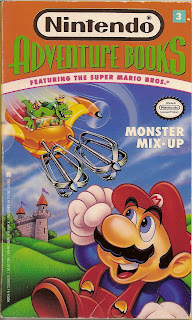Monday, January 17, 2011
Nintendo Adventure Books 3: Monster Mix-Up
After Clyde Bosco’s one-two punch of duplicated monsters and mushroom Olympics we’re treated to the stylings of Bill McCay. It won’t be long until you’re wishing Bosco had come back for another book.
Mario and his buddies are attending a circus when the princess suddenly disappears and he and Toad are faced with an onslaught of Koopa monsters that have been mixed together. That’s it for the plot, really.
The rest of the book is a series of short paths as Mario tries to make his way across the generic environs of the Mushroom Kingdom to Bowser’s castle to rescue his friends, and the narrative makes it perfectly clear why this approach can be acceptable for a videogame but not a book. In the games, you’re focusing on the screen and pushing buttons to avoid the perils. In Monster Mix-Up you’re reading about Mario running around and occasionally decide if he should go up or down, left or right, and by the third time the fun has long since worn off.
It really does feel like McCay was trying to capture the feeling of playing the games (especially based on his next book), but if that’s what you want wouldn’t just fire up the Nintendo rather than crack open a book?
Not to mention that despite the premise being an attack of mixed-up monsters, it’s easy to read through the book while running into hardly any of them. Especially if you manage to find the one crucial item you need early on and don’t need to be sent back to near the beginning of the book to get it
Scoring might be the most irritating thing about the book, as unlike the previous two where coins tended to come in clumps, McCay once again seemed to be trying to recreate the experience of SMB3. In numerous paths Mario will get his hands on two or three coins, forcing you to regularly flip to the last page to record an amount of coins that doesn’t seem worth the trouble. It would interrupt the flow of the adventure too, if the adventure had any to begin with.
The book is just one grating thing after another. There’s nothing wrong with wanting to be faithful to the source material, but with a different medium comes a different set of expectations.
Labels:
Gamebooks
Subscribe to:
Post Comments (Atom)



No comments:
Post a Comment